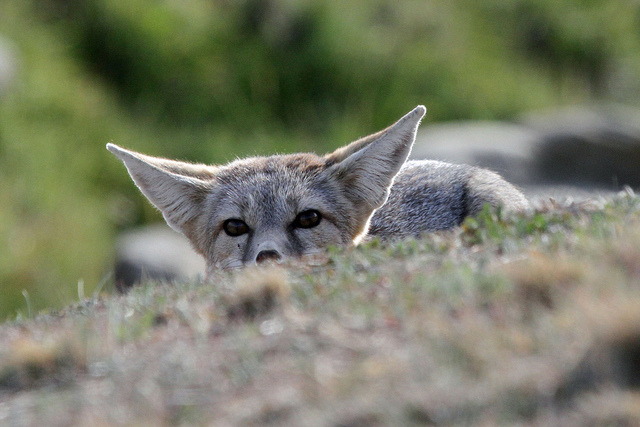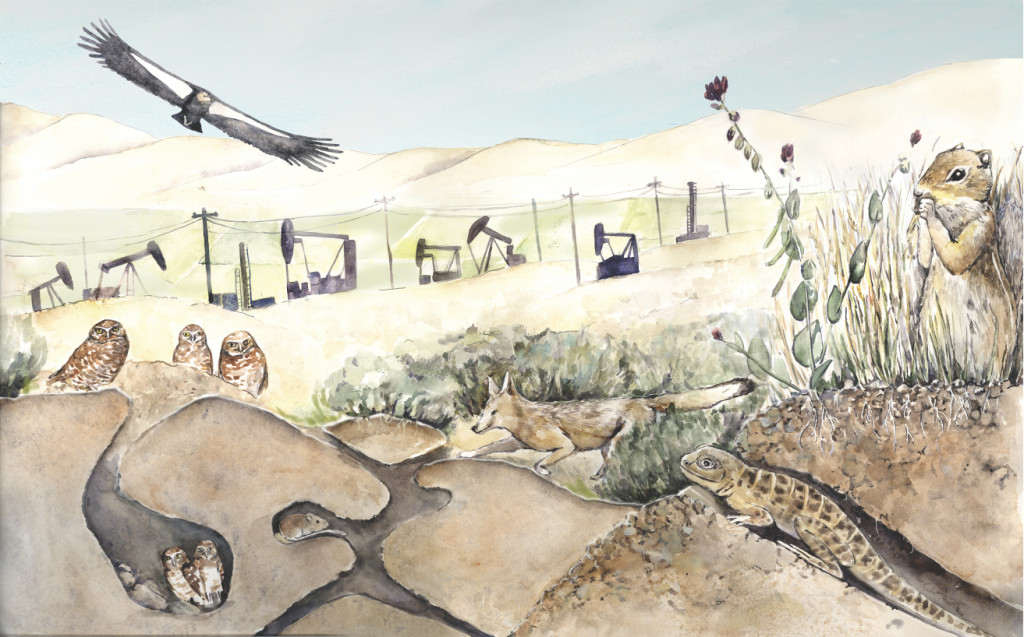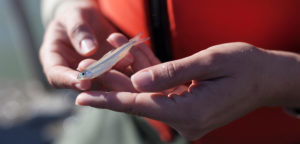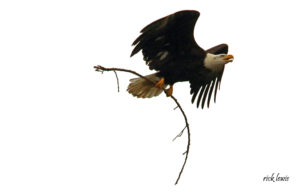In late 2012, the federal Bureau of Land Management auctioned a slew of leases for oil exploration in the Monterey Shale as far north as the inner Coast Range habitat that borders the southern flank of the Bay Area.
It’s a place that’s home to a number of endangered species: the San Joaquin kit fox, the giant kangaroo rat and the blunt-nosed lizard, to name a few. The impacts of oil exploration and development on such native species is a big unknown, so much so that environmentalists sued the federal agency for not conducting an environmental impact report before auctioning off the lands. The debate remains: how does “extreme energy” extraction, such as hydraulic fracturing, affect the native species that call this land home?
In this story in the Bay Nature series on the impacts of extreme energy, we’re focusing on the species that make a home of the lands above the Monterey shale. As the California condor soars above, there are a number of endangered desert species that would be impacted by development on the land. Accustomed to thriving in scarcity, they’ve come to depend on an ecosystem managed by large grazers — namely cattle — whose presence is necessary but potentially threatened by the arrival of an oil boom.
In the heat of the night
To better understand what lives above the Monterey Formation, and what challenges these species face, I ended up one hot July evening on a kit fox survey. I met BLM biologist Mike Westphal at the agency’s Hollister field office as he was loading a truck with spotlights and binoculars.

It turns out summer is a bad time to survey plants, but San Joaquin kit foxes, the smallest foxes in North America, are most active at this time of the year.
We are headed for the desert badlands of the Panoche Hills in San Benito County, which has consistent populations of kit foxes and giant kangaroo rats. As we drive along Interstate 5, Westphal says the biggest threat to these species is habitat loss — namely from agriculture.

“The real threat is that,” he says, pointing to almond orchards that march in green lines across the valley floor. “There’s no leopard lizards in that.”
The problem, Westphal says, is that kit foxes, giant kangaroo rats, and blunt-nosed leopard lizards are desert species.
“They only live where land is bare,” he says. “Originally, this region was covered with scattered shrubs, bare ground, and desert.”
But with development came non-native grasses, and where non-native grasses are thick, endangered species vanish, Westphal says.
Ranching is a better match for desert species, because grazing keeps grasses short and soil bare, Westphal adds. We pass bone-dry hillsides where cows are still grazing in the dying light.
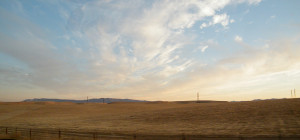
“People used to think this land was being overgrazed, but it’s bare because it can’t support anything,” he says. “If we keep with the ranches, endangered species and the ranches win.”
Fracking is another story. Environmentalists worry that fracking could push endangered species over the edge by polluting the land and water with dangerous chemicals. Furthermore, there’s an intricate balance between kit foxes, giant kangaroo rats, and blunt-nosed leopard lizards, since kit foxes hunt kangaroo rats and leopards live in abandoned burrows. So, fracking-related impacts on any one of these species would have a domino effect on the other species.
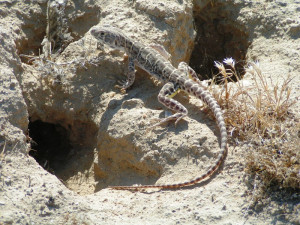
But Westphal takes a more liesurely stance on oil development (he worries more about a solar plant planned for the Panoche Valley). He says some of the 2012 leases specify “no surface occupancy,” which means oil developers can’t place a well pad on the surface of the land, rendering the impact on the land, and the leases’ value arguably minimal at this stage, although all that could, of course, change at some point
“People buy the leases anyway. It’s like Monopoly money,” Westphal says, alluding to the speculative nature of an industry that has plenty to gain if investors believe the next oil bonanza will take off in California.
“We can’t tell what the future is. We do environmental assessments on what we’ve got.”
Off the beaten track
We turn off the highway and wind along bumpy roads, past ridges, canyons, and ranch lands dotted with salt brush and discarded beer bottles, until we reach a dry and mostly flat windswept plateau.
“Where it’s flat, that’s where the foxes live,” Westphal says. He stops to don goggles and a miner’s lamp—necessary equipment to see anything in the hot, dusty wind that is blowing across this mostly barren plateau.
“You want to hold the spotlight up,” he adds, as I sweep the grasslands for signs of life.
A pair of brown eyes shines back.
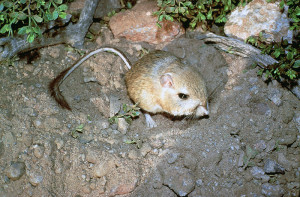
“That’s possibly a giant kangaroo rat,” says Westphal, noting that the rat’s eyes are brown, while foxes are emerald. He points to the numerous flat mounds on the plateau’s surface, which indicate that we are in the middle of a giant kangaroo rat precinct.
Each mound marks the territorial center of individual rats, which clip plants from around their precinct and cure seedheads in the sun before storing them in their underground burrows. The rats’ seed hoarding behavior helps create favorable microhabitats for San Joaquin woolly-threads and California jewel flowers, but it may also promote non-native grasses, Westphal says.
Giant kangaroo rats are mostly nocturnal, but tonight we see very few. Westphal speculates that their absence is related to the drought: plants ripened early this year, so the rats may have finished seed gathering and have little the need to go outside, where they risk being hunted.
We drive deeper into the Panoche Valley, and as we sweep a maze of ridges and canyons, a pair of emerald eyes blinks in a dry creekbed.
“There it is!” Westphal shouts.
“There’s two of them,” he adds, as another pair of eyes blinks. “And they are too low to the ground to be coyotes.”

Westphal carries out night surveys for endangered species a couple of times a year and admits that they are not his favorite survey method (you never know if you’re seeing the same foxes each time). Instead, he prefers to hire a dog team trained to find scat that goes out in the morning when kit foxes are asleep.
“In the last 4 years, we have collected almost 1,000 scats and genotyped 100 individual foxes,” he says.
He’s also counted two “strikes” this year alone: kit foxes hit by cars. And tonight he spots a dead giant kangaroo rat in the road.
“The biggest threat is development,” he says, again.
Desert water
Despite the late hour, it’s still hot. As I take a swig from my water bottle, Westphal offers that a decline in water quantity and quality aren’t immediate issues for foxes and other desert species. But water issues could have a secondary effect on these natives if fracking drives out ranchers.
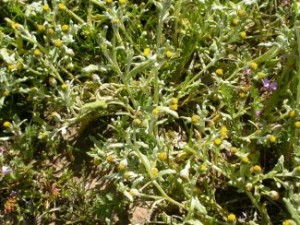
“Kit foxes don’t drink, at least not in their natural habitat, and they eat animals that don’t drink and that partake of drought-tolerant plants,” he says. “But if the water impact of fracking meant you couldn’t water cattle, and that drove the cattle off the land, then you wouldn’t be able to graze the grasslands any more, and that would impact the native species.”
It’s almost 1 a.m. as we arrive back in Hollister. I ask Westphal about the studies underway to determine the distribution and genetic differences of different populations of legless lizards in the San Joaquin Valley—a discovery that could add to BLM’s list of species of concern. Westphal smiles.
“If legless lizards are given a higher level of species protection, we will survey the bejeezus out of these lands.”
Critical habitat for vulnerable and endangered species in the Monterey Shale. Note: Click on areas to view species’ profiles.
Preview of our next installment: The riches beneath the soil.
Why is the Monterey Shale potentially so valuable? How did the riches of the land in the form of creatures the size of a pinhead get locked down over the millennia to form oil? We explore the natural history of the landscape with geologist Mel Erskine.
Read our first story in Bay Nature’s fracking series: In condor country comes a California oil boom.
Read our second story in the series: Above the Monterey Shale, farmers worry fracking will destroy the land.
Sarah Phelan is a contributor to Bay Nature and is leading our coverage on Extreme Energy in the Monterey Shale.

